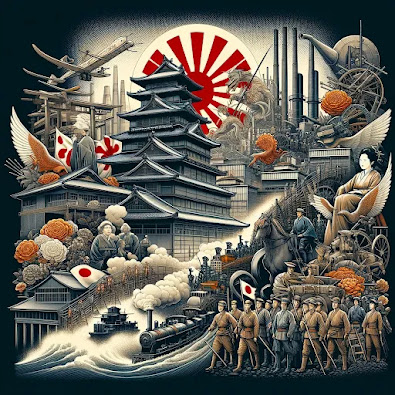The Dawn of a New Era
In the latter half of the 19th century, Japan stood on the cusp of a monumental transformation. The Meiji Restoration of 1868 catapulted the nation from the depths of feudal isolation into the forefront of global industrialization. This pivotal event not only centralized power under Emperor Meiji but also set the stage for sweeping reforms that would redefine Japan's place in the world.
Embracing Modernization with the Meiji Restoration
The Meiji era heralded a comprehensive overhaul of Japanese society. The government systematically dismantled the feudal system, replacing it with a centralized bureaucratic state modeled after Western nations. Radical reforms in every sector characterized this period. In education, they introduced a compulsory system to eliminate illiteracy and foster a skilled workforce. The military underwent modernization, adopting conscription and Western tactics, transforming it into a formidable force.
The Industrial Revolution: Japan's Leap Forward
By embracing Western technologies, Japan initiated an industrial revolution within its borders. The establishment of factories, particularly in textiles, and the development of railways catalyzed urbanization and economic growth. By the early 20th century, Japan's shipbuilding industry had become one of the world's largest, enabling its expansion into global markets and solidifying its status as an industrial titan.
The Path of Expansionism
Japan embarked on a series of military campaigns driven by a desire for resources and geopolitical power. The Sino-Japanese War (1894-1895) victory and the Russo-Japanese War (1904-1905) humbled two of Asia's significant powers and secured Japan's dominance over Korea, Taiwan, and parts of Manchuria. These conquests made Japan a burgeoning imperial power eager to extend its reach across Asia.
World War I and the Accrual of Power
Japan's entry into World War I on the Allies' side further augmented its territory and influence. Post-war treaties and agreements expanded Japanese control over former German colonies and increased its sway in China, laying the groundwork for future regional conflicts.
A Nation at a Crossroads: Political Upheaval and the Rise of Militarism
The interwar period was marked by political tumult. The assassination of Prime Minister Hara Takashi in 1921 underscored the volatility of Japanese politics as factions vied for control. The 1930s saw the military exerting unprecedented influence over the government, steering Japan towards a doctrine of militarism and expansionism. This shift was crystallized by the 1931 invasion of Manchuria and the establishment of a puppet state, signaling Japan's aggressive stance towards China and setting the stage for the Second Sino-Japanese War.
The Onslaught in China: Prelude to Global War
Japan's invasion of China in 1937 epitomized the brutality of its expansionist ambitions. The conflict, marked by the horrific atrocities of the Nanjing Massacre, showcased the devastating human cost of Japan's imperial aspirations. This aggressive posture alienated international powers and set Japan on a collision course with the global community, culminating in its entry into World War II as an Axis Power.
Conclusion: Japan's Transformation and Its Global Implications
In the decades leading to World War II, Japan radically transformed from a feudal society to a modern industrialized power. Its rapid modernization, aggressive expansionism, and militarization fundamentally altered the geopolitical landscape of Asia and contributed to the outbreak of global conflict. Japan's journey to World War II reflects the complex interplay of internal reforms and external ambitions, highlighting the profound impact of national policies on world history.














0 Comments